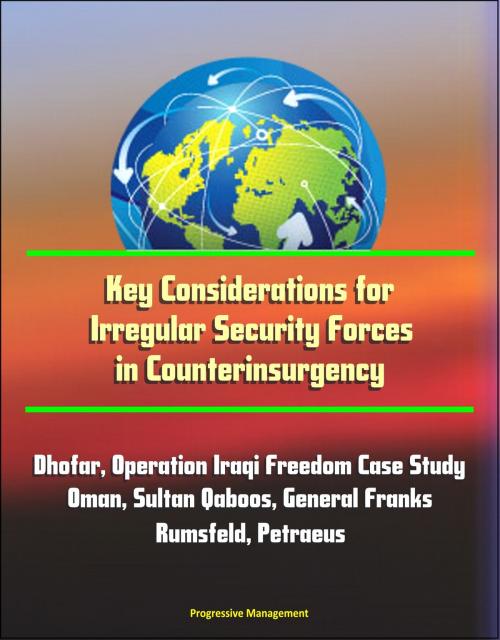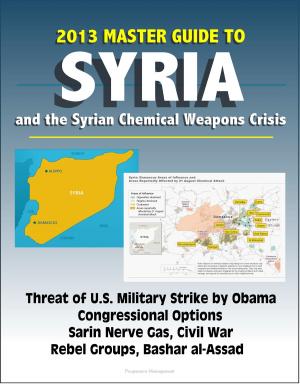Key Considerations for Irregular Security Forces in Counterinsurgency: Dhofar, Operation Iraqi Freedom Case Study, Oman, Sultan Qaboos, General Franks, Rumsfeld, Petraeus
Nonfiction, History, Military| Author: | Progressive Management | ISBN: | 9781310559389 |
| Publisher: | Progressive Management | Publication: | April 8, 2014 |
| Imprint: | Smashwords Edition | Language: | English |
| Author: | Progressive Management |
| ISBN: | 9781310559389 |
| Publisher: | Progressive Management |
| Publication: | April 8, 2014 |
| Imprint: | Smashwords Edition |
| Language: | English |
Counterinsurgents have raised and employed irregular security forces in many campaigns over the last century. Irregular security forces are indigenous forces, not part of the regular police or military organizations of the host nation, that are recruited locally to provide a basic level of security in a given area. Irregular security forces, when used in conjunction with all other available capabilities, contribute to, but do not in and of themselves, ensure success. While irregular security forces can be effective in conducting local security, intelligence gathering, surveillance and other tasks in their home areas, tasks that may prove more difficult for regular security forces, irregular forces are no silver bullet to achieving success. Counterinsurgency is a struggle for the support of the population against an active and thinking enemy and therefore, there are no hard and fast rules. Several counterinsurgency scholars and theorists do, however, agree on several key principles that can aid counterinsurgents in prosecuting their campaigns successfully. This paper seeks to add to the body of knowledge by examining the key aspects that counterinsurgents should take into account when considering raising an irregular security force.
Mankind has waged insurgencies and counterinsurgencies throughout history. Despite the large volume of material available for the study of these forms of conflict, there yet remains a great deal of myth and confusion surrounding insurgency and counterinsurgency. Modern western militaries largely neglected the study of counterinsurgency prior to the attacks on the United States on 11 September 2001. Stung by the loss in Vietnam, the US military chose to minimize counterinsurgency and focused on the conventional warfare which it preferred and was better trained, organized, and equipped to conduct.
This choice was not merely academic, but impacted the way the Army trained, procured equipment, educated its leaders, and prepared for war. As Jonathan M. House wrote in Combined Arms Warfare in the Twentieth Century, "To meet the challenge of the wars of national liberation, Western armies had two choices - they could attempt to adapt their conventional forces to a style of war for which they were not intended, or they could neglect the development of new generations of armored weapons in favor of a renewed interest in light infantry forces." Should the United States expend the bulk of its resources to prepare its forces to win proxy wars of insurgency and counterinsurgency, or should it remain prepared to win the less likely but more serious conventional conflict with the Soviet Union? After Vietnam the choice was clear, and counterinsurgency was mostly discarded by the conventional force as a task for Special Forces.
As the United States focused more on the possible conventional fight between the North Atlantic Treaty Alliance (NATO) and the Soviet-backed Warsaw Pact, American strategy and doctrine envisaged a battle against numerically superior enemy forces which required a defensive posture reliant more on firepower than maneuver. In order to increase the odds of survival against a numerically superior enemy, American military leaders pressed for weapons systems with greater precision in an attempt to improve the Army's odds on the battlefield.
Counterinsurgents have raised and employed irregular security forces in many campaigns over the last century. Irregular security forces are indigenous forces, not part of the regular police or military organizations of the host nation, that are recruited locally to provide a basic level of security in a given area. Irregular security forces, when used in conjunction with all other available capabilities, contribute to, but do not in and of themselves, ensure success. While irregular security forces can be effective in conducting local security, intelligence gathering, surveillance and other tasks in their home areas, tasks that may prove more difficult for regular security forces, irregular forces are no silver bullet to achieving success. Counterinsurgency is a struggle for the support of the population against an active and thinking enemy and therefore, there are no hard and fast rules. Several counterinsurgency scholars and theorists do, however, agree on several key principles that can aid counterinsurgents in prosecuting their campaigns successfully. This paper seeks to add to the body of knowledge by examining the key aspects that counterinsurgents should take into account when considering raising an irregular security force.
Mankind has waged insurgencies and counterinsurgencies throughout history. Despite the large volume of material available for the study of these forms of conflict, there yet remains a great deal of myth and confusion surrounding insurgency and counterinsurgency. Modern western militaries largely neglected the study of counterinsurgency prior to the attacks on the United States on 11 September 2001. Stung by the loss in Vietnam, the US military chose to minimize counterinsurgency and focused on the conventional warfare which it preferred and was better trained, organized, and equipped to conduct.
This choice was not merely academic, but impacted the way the Army trained, procured equipment, educated its leaders, and prepared for war. As Jonathan M. House wrote in Combined Arms Warfare in the Twentieth Century, "To meet the challenge of the wars of national liberation, Western armies had two choices - they could attempt to adapt their conventional forces to a style of war for which they were not intended, or they could neglect the development of new generations of armored weapons in favor of a renewed interest in light infantry forces." Should the United States expend the bulk of its resources to prepare its forces to win proxy wars of insurgency and counterinsurgency, or should it remain prepared to win the less likely but more serious conventional conflict with the Soviet Union? After Vietnam the choice was clear, and counterinsurgency was mostly discarded by the conventional force as a task for Special Forces.
As the United States focused more on the possible conventional fight between the North Atlantic Treaty Alliance (NATO) and the Soviet-backed Warsaw Pact, American strategy and doctrine envisaged a battle against numerically superior enemy forces which required a defensive posture reliant more on firepower than maneuver. In order to increase the odds of survival against a numerically superior enemy, American military leaders pressed for weapons systems with greater precision in an attempt to improve the Army's odds on the battlefield.















